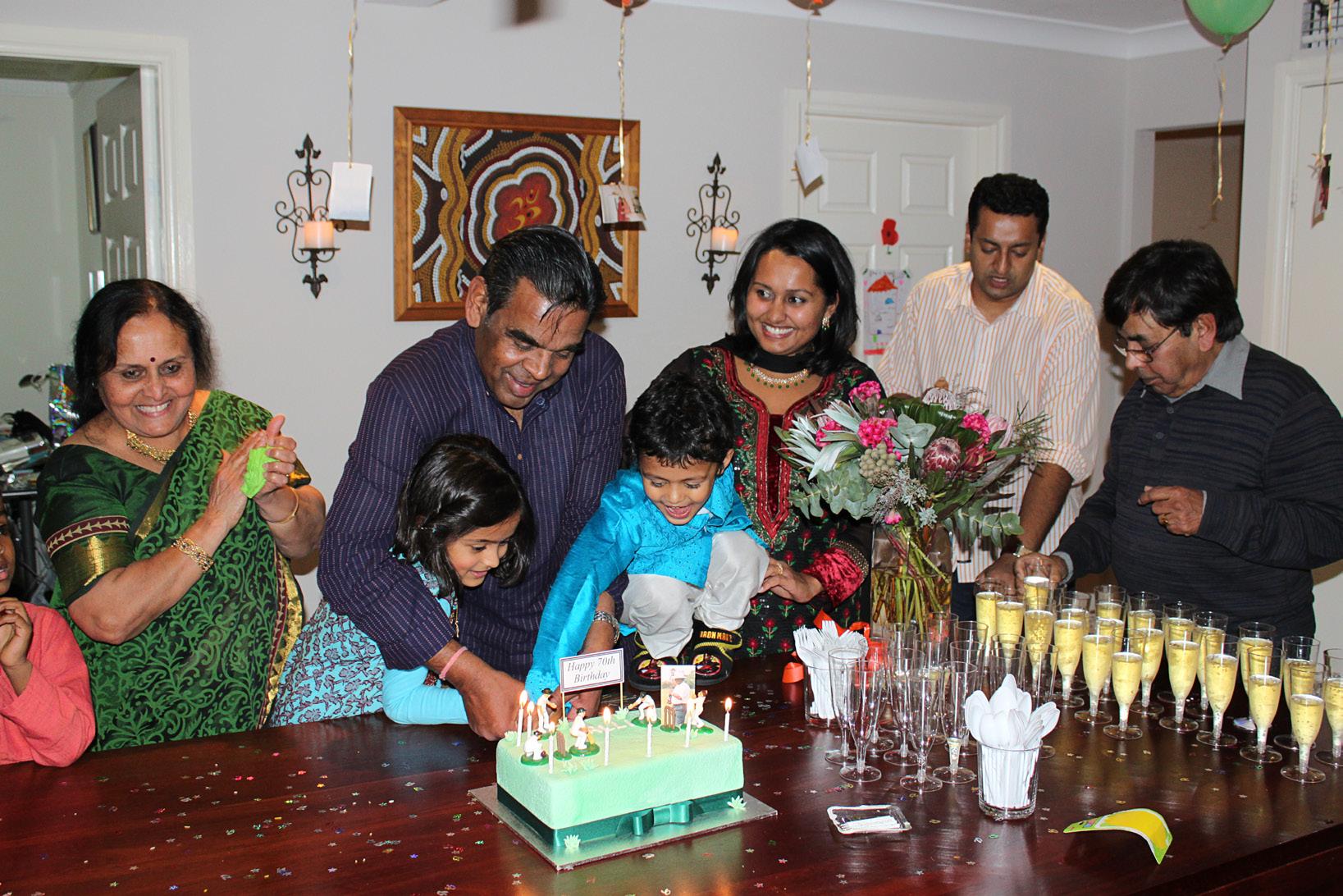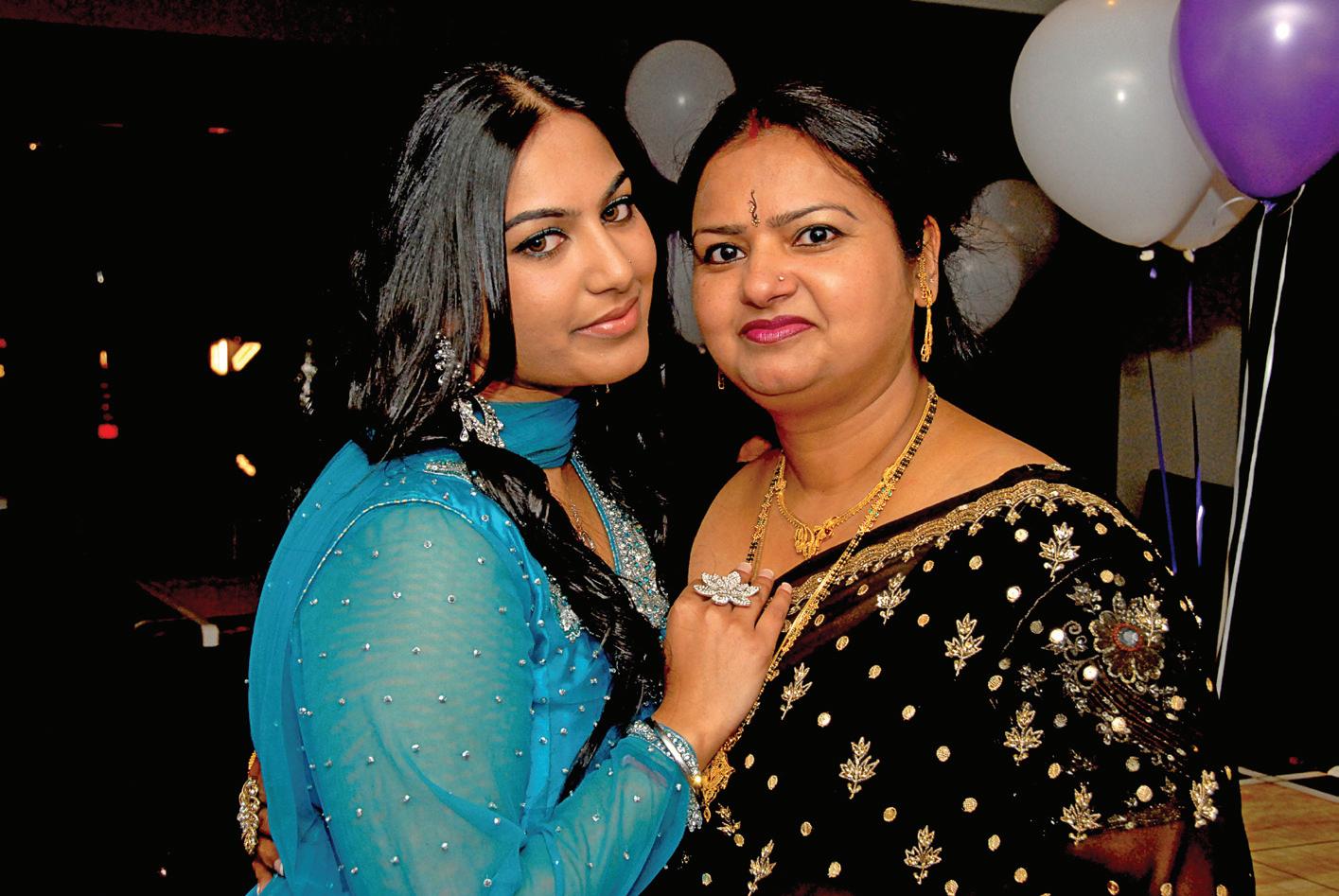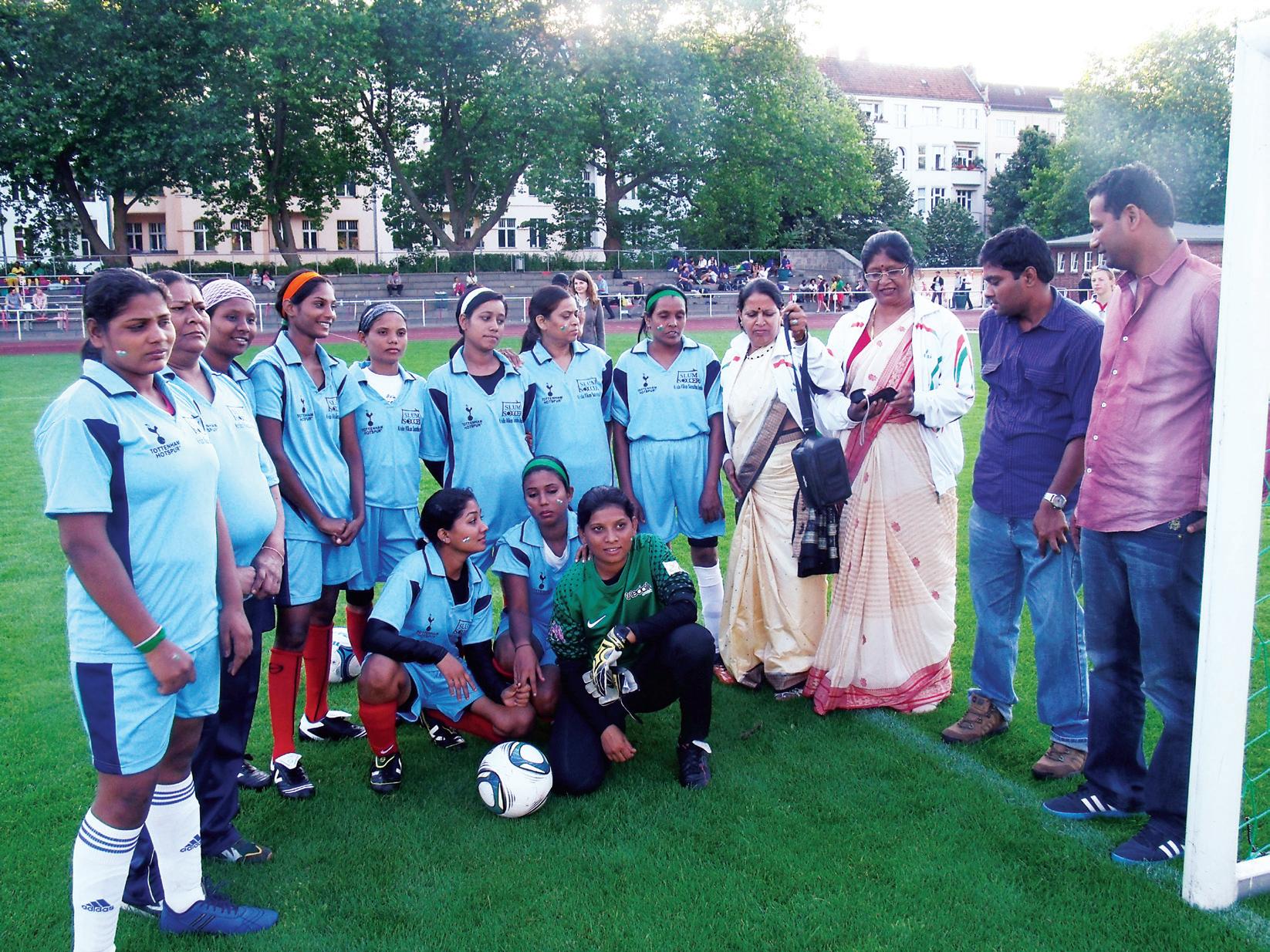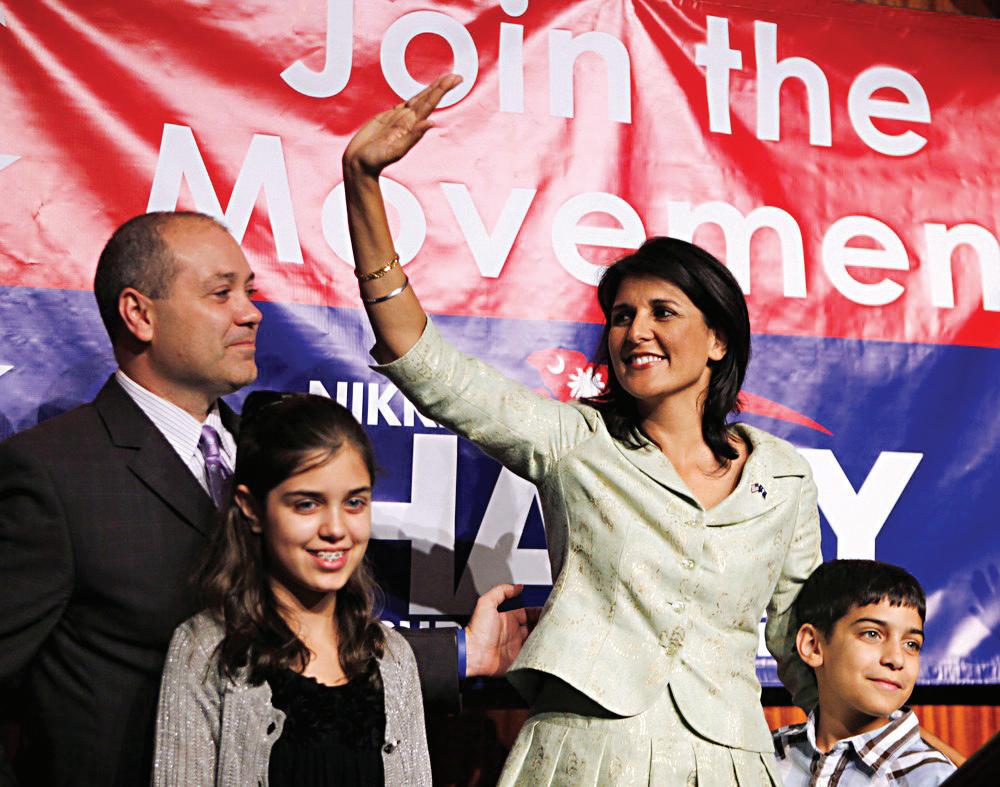
39 minute read
Culinary odyssey to India
from 2011-07 Sydney (1)
by Indian Link
A rare opportunity to join acclaimed Sydney chef Carol Selva Rajah on a week food and cultural exploration in India
BY SANDIP HOR
Travelling through India, a land of contrasts and striking diversities, is just not a journey, but an experience of a lifetime. The region, with its vast bounties of nature, steeping history and great treasures of art and culture, provides today an array of encapsulating encounters to a visitor.

As one travels from one part of the country to the other, what strikes out is the changing panorama of style, culture and physical environment that brings out the uniqueness of the region. Cuisine is an important and distinct character of that diversity that itself creates an interest for many to explore the region and I suppose there is no better person than eminent food personality Carol Selva Rajah to take you through that odyssey.
Coming September, she will lead a small group tour to give food connoisseurs a taste of India’s history and culture through the stomach by offering them some intriguing recipes from royal kitchens of Hyderabad to street food corners of Mumbai.
Carol Selva Rajah needs no introduction within the curry circle in this country. She is a celebrated chef, consultant, writer, teacher and guide. Her award winning book The Food of India, which adorns the shelves of bookstores in Australia, UK and the US, has inspired many to switch over from fish and chips to hot and spicy alternatives.
She is a veteran of many culinary tours to India and South Asia.

“The coriander, cumin and mustard aromas with the flavours of chutneys, dahl, curries and masalas create a kaleidoscope of images that clarify into a vibrant picture of the India I visit often with friends,” she says.
By joining her in the forthcoming two-week tour commencing 15 September, you will visit great places like Hyderabad, Mumbai, Goa, Cochin and Trivandrum; see places of historical and cultural interest; learn from many interesting secrets about spices and herbs used in Indian cuisine; explore the vibrant bazaars from where the various ingredients are sourced; learn the art of gourmet cooking; taste and savour an array of dishes that will tantalise your appetite and keep mouth watering forever; and most importantly have fun.
During the tour you will have the rare opportunity to understand from Carol how feeding the mind is just as important as feeding the body. As one of Australia’s most celebrated experts in Asian cuisine, she firmly believes food cooked from the heart is the best gift one can give to family and friends. You will experience that when sampling exotic Moghul dishes like Biriyani and Korma in Hyderabad,
India.
The fund is a joint initiative of the Australian and Indian governments. It is Australia’s largest bilateral research fund, providing AU$65 million over eight years.
Australian Innovation Minister, Senator Kim Carr said, “India is a strong research nation in its own right and a rising scientific power. Both countries have much to gain from collaboration in science and technology.”
“This funding will enable leading Australian and Indian scientists to combine their unique strengths and tackle big issues facing communities in Australia and India –such as growing healthy crops and protecting precious groundwater environments.”
Grants have been awarded to a total of 12 different Australian universities and research institutions including James Cook University, CSIRO, the Victor Chang Cardiac Research Institute, the Australian National University, Melbourne University, the University of Western Australia and the University of Queensland.
Grants have also been awarded to a total of 14 Indian collaborating partner institutions including the Indian Institute of Technology Bombay, the Indian Institute of Science Bangalore, Raman Research Institute and the International Centre for Genetic Engineering and Biotechnology.
Projects to be supported under Round 5 of the fund include:
• development of a novel class of anticancer agents targeting the immune system;
• design of malaria vaccines;
• developing methods for the production of omega-3 concentrates for functional foods, pharmaceuticals and nutraceuticals;
• improving high-temperature tolerance in crop plants; and
• advancing our ability to predict plant distributions under changed climates. Other projects supported by the fund are in nanotechnology, marine and earth sciences, biomedical devices and implants, and stem cells.
Parsi delicacy Dhansak in Mumbai or Portuguese hit Vindalu in Goa - all washed down with loads of Kingfisher beer, may be Cashew Feni in Goa or Todi in Cochin.
The itinerary, which epitomises what an expert hostess would like to do with her valued guests, was launched to an exclusive gathering of travel enthusiasts last week at a cocktail function hosted by Arnold De Souza from ACR Travels. If you are interested in joining, call ACR Travels in Sydney on 02 8252 8777.









MEET WORLD FAMOUS ASTROLOGER & PALM READER WHO IS AN ASTROLOGER FROM GENERATIONS



If you are worldly unhappy for thr following reasons :
Loss of Business, Unsuccessful Family Life, Lacking Love & Peace, Your Children Misguided By Your Enemies & Relatives, Suffering From Any Disease And you are under the the eveil effects.
If Your are suffering from Bad Luck, Problems in Career, Jobs or Exams, Cour Cases Business, Difficulties, Love Marriage, Relationship Problems or Loved one have left your or Separated from you without giving any reason. I can Help you to bring him / her Back to you and help with any other problem.
HE CAN PREDICT ACCURATELY ABOUT YOUR PAST- PRESENT – FUTURE
Pandit Ji is an Astrologer Palm Reader, Face Reader, Numerologist, Spritualist, Vedic, Vaastu Expert, Psychologist, Expert in “Tantrik” from Generations
CALL
NOW
Kerala temple treasure trove continues to astound
A legend temporarily halted the stocktaking at the Sri Padmanabhaswamy temple in Thiruvananthapuram, Kerala where treasures said to be worth Rs.1 lakh crore have been found.

Monday, July 4 was the seventh day of knowing how many valuables were packed in the six chambers, two of them not opened for nearly 150 years. The Supreme Court had ordered the exercise. Retired judge M.N. Krishnan told reporters that “some sort of expertise” would be needed to open chamber B.
Krishnan said a seven-member committee appointed by the Supreme Court and headed by him will meet soon. “I have nothing more to say.”
The committee is making an inventory of the six chambers in the temple premise.
The estimated worth of the gems and jewellery found in five of the six chambers is unofficially put at a whopping Rs.1 lakh crore ($22 billion). The committee has not confirmed this figure.
The erstwhile royal family of Travanacore, which maintains the temple, believes that opening chamber B would be a bad omen.
A royal family source revealed that many legends were attached to the temple and that chamber B has a model of a snake on the main door.
“This is a clear indication that the door should not be opened because opening it might be a bad omen. I don’t think the team can open it because there is a lot of faith attached to the temple,” said the source.
Another legend says that there is a tunnel at the bottom of the chamber that leads to the sea.
The stocktaking was ordered by the Supreme Court following a petition by advocate T.P. Sundararajan over alleged mismanagement of the temple affairs.
The team is expected to present an interim report to the Supreme Court.
Tight security arrangements are in place in the temple premises. A 24-hour police control room has been opened and round-the-clock mobile patrolling is on.
“A 24-hour special police control room has been opened at the Fort Police station. Round-the-clock mobile patrolling would be started and permanent security arrangements would also be provided,” Kerala Chief Minister Oommen Chandy said recently. “This temple is our state’s pride...and is part of our culture. Hence it is the government’s right and duty to provide the needed security to the temple,” the chief minister added.
He also emphasised that the treasure is the property of the temple.
Chandy added that when a permanent security cover is set up, it would be done by taking into confidence the head of the erstwhile royal family of Travancore.
The Sri Padmanabhaswamy temple in Kerala could well be the richest in the country as on the sixth day of preparing an inventory of treasures in its six chambers, it is suggested the value of its gold, diamond and other precious metals at close to Rs. 1 lakh crore.
Two more chambers are left unopened and it is expected that the inventory process may continue for a few more days.
The committee, which includes a gemmologist, stumbled upon a nearly fourfoot-tall statue of Lord Vishnu in gold and studded with emeralds. Other precious items that were accounted for included several golden statues, almost all weighing two kg each. Among other things are a gold necklace as long as 15 feet, and crowns studded with emeralds, rubies and diamonds.
The chamber is situated around 20 feet under the ground. The committee conducted the examination using artificial lights. Cylinders were used to pump in oxygen to the chamber to guard against breathing problems for committee members.
Gopalakrishnan said that according to the legend the gold got accumulated in the temple because in the olden days people used to offer gold to seek pardon from the royal family.
The main temple deity, Padmanabhaswamy, is a form of Hindu god Vishnu in Anananthasayanam posture or in eternal sleep of ‘yognidra’.
The foundation of the present entrance gateway was laid in 1566 and the temple has a 100-foot, seven-tier tower besides a corridor with 365 and one-quarter sculptured granite stone pillars with elaborate carvings.
As of now, the Balaji temple in Tirupati in Andhra Pradesh is believed to be the richest temple in the country, followed by Shirdi Sai Baba shrine in Maharashtra.
The erstwhile royal family of Travancore in Kerala is thrilled that valuables worth thousands of crores have been discovered in the chambers of a temple it manages.
The head of the royal family of Travancore, Uthradom Thirunal Marthanda Varma, was tight lipped on the discovery and said: “I have nothing to say on this because one has to abide by the ruling of the apex court.”
Varma is the managing trustee of the trust that runs the temple.
One of the members of the royal family said: “How many royal families in the country can be proud of keeping things like this? You should understand that two chambers out of the six have not been opened for more than 150 years and it there that the treasure trove has been kept safely”.
A journey from Indian slums to Germany - for football
Khushali Darbeshwar, 19, pinched herself several times as she watched the opening ceremony of the women’s football World Cup in a jam-packed Olympic Stadium in Berlin on June 29. From an Indian slum to Germany - it was like a fairytale dream for her to witness tournament - Discover Football, a global initiative to help disadvantaged girls, challenge societal norms and make a mark.
“I have never ever in my dreams thought about watching the women’s World Cup opening ceremony and the first match of Germany against Canada. I pinched myself several times to feel if this was a reality or not,” an excited Khushali said with a wide smile.
Being held on the sidelines of FIFA Women’s World Cup, Discover Football has brought together eight teams from across the world for an international women’s football tournament in the centre of Berlin.
The June 27-July 3 tournament is seeing the participation of women’s teams from India, France, Brazil, Israel, Togo, Cameroon and Rwanda, as also a team from Berlin. The teams have been selected by Streetfootballworld from a list of 38 applicants.
The tournament is accompanied by a diverse cultural festival.
Slum Soccer - the Indian team -- lost their first match against Berlin, but there is no dearth of confidence among the players as they are looking forward to other matches and a global exposure.
“The Berlin team has practised for a month with football experts of the national team. It was a learning experience, but I am more excited after watching the World Cup opening ceremony ... it was breathtaking,” said Priyanka Arun Ragit, daughter of a daily wage labourer in Nagpur, who plays as a forward.
Slum Soccer was founded by a Nagpurbased NGO that trains underprivileged children and youth from across India in football.
For most of the girls, the journey from slums to football was a challenging task, but they fought back to follow their dreams.
Shehnaz Kureshi, 19, took to football as the boys in her class challenged her that girls can never play the game.
“I was interested in football but it is said to be a masculine game. I never tried it till I was challenged by the boys. When I started, I used to play with boys as none of the girls played the game, but now things have improved,” said Shehnaz, with the Indian tricolour painted on her cheeks.
This second year humanities student, who was abandoned by her father for being a girl child, had to fight both family and society to play football.
But now she is a star in her slum near Nagpur.
“People in my slum now look with respect and pride at me and even my mother is happy as I have also started earning by coaching children in football. Most of the girls in my locality now play football,” Shehnaz said confidently.
Slum Soccer was launched in 2001 with a vision to equip the underprivileged to deal with and emerge from the disadvantages riding on their homelessness using the medium of football.
“It was started by my father, but we started focussing on football in 2007 and decided to use it as a tool to bring a change in society,” Slum Soccer CEO Abhijeet Barse said.
Barse left his doctorate in environment studies in the US in 2007 to concentrate on Slum Soccer. Since then he has never looked back and Slum Soccer is making a mark everywhere.
“We have training centres in several parts of central India and will soon start one in Chennai. We have 12 volunteers and a fund-raising team. We are also developing a curriculum using football as medium for development and making the whole process more self-sustainable for players,” he said.
In 2010, Slum Soccer participated in the Homeless World Cup in Brazil and India won the Fairplay Award.
In exile, Husain wanted to destroy his paintings
Forced to live away from India, M.F. Husain at one time wanted to destroy all his paintings, says his son Owais Husain who is hungering to conquer the wasteland of possibilities left behind by his illustrious father.
“I feel suddenly in life there is a wasteland in front of me, but the wasteland is rich, inspiring a hunger in me to devour the wasteland. I am ready, actually I am doing that,” Owais Husain, who is making a documentary on his father, said recently in New Delhi.
Recalling one of his father’s bouts of despair after his self-imposed exile from India, Owais, the youngest son of artist M.F. Husain, said, “There was a time he wanted to destroy all his paintings. What was the use, he said.” Owais, an artist and filmmaker, was in Delhi with brothers Shafqat, Shamshad and Mustaq to pay tribute to their father at a commemorative celebration by the Safdar Hashmi Memorial Trust.
M.F. Husain passed away June 9 in London after a cardiac failure at 95. He had left India in 2006 after being threatened by Hindu radicals over his paintings.
Owais’ movie, Letters to My Son about My Father, is a generational father-to-son narrative about the family’s illustrious brush with art and fame - from the obscure areas of Maharashtra and Madhya Pradesh to the bright lights of Mumbai and the world - riding on the patriarch, M.F. Husain.
“It will be a document of his life - capturing his journey as an artist and a man. I want to tell the story to my son - from a father to the son and address the posterity through him. I still have a few more interviews to do before I put it all together. I am also using family footage. But I am yet to find a close (end) to
Continued on page 38
Continued from page 37 the movie - don’t yet know how I will end it,” Owais said.
The documentary will use “classical music, photographs and several genres of art that Husain loved”, his son said.
M.F. Husain, who experimented with filmmaking between his vocation and commissions - public art, historical series and installations - made three major filmsThrough the Eyes of a Painter, Gajagamini, Meenaxi: Tale of Three Cities - that combined art, narratives, characters and music.
One of the movies, Through the Eyes of a Painter, which had won a Golden Bear at the Berlin Film Festival in 1967, was screened in the capital recently.
A 16-minute documentary, it was shot by the painter during his journey through Rajasthan. “The documentary, Through the Eyes… is inspiring,” said Owais, who is in his mid thirties.
The younger Husain said his father had completed two mega series of paintings - History of Arab Civilisation, History of Indian Civilisation before his demise.
“He kept painting till his death,” he said. Owais’ roster is crammed. “I have three films on the floor. There is a solo exhibition of my art works at Gallery Espace in the capital in October. It will be a bit of a ‘dhamaka’ - I have tried new formats and language,” he said.
Supreme Court says government evasive on black money
The Supreme Court, while appointing a Special Investigation Team (SIT) to probe the black money parked by Indian citizens in tax havens abroad, pulled no punches in chiding the government for being evasive and in the denial mode.
While constituting an SIT headed by former Supreme Court judge B.P. Jeevan Reddy, the court said lack of seriousness in the government’s efforts was contrary to the requirements of law and its constitutional obligations.
The apex court bench of Justice B. Sudershan Reddy and Justice S.S. Nijjar, which ordered the setting up of the SIT, said: “We must express our serious reservations about the responses of the Union of India. In the first instance, during the earlier phases of hearing before us, the attempts were clearly evasive, confused or originating in the denial mode.”
Speaking for the bench, Justice Sudershan Reddy said: “It was only upon being repeatedly pressed by us did the Union of India begin to admit that indeed the investigation was proceeding very slowly.”
“It also became clear to us that, in fact, the investigation had completely stalled, in as much as custodial interrogation of Hasan Ali Khan had not even been sought for, even though he was very much residing in India,” he said.
Stashing away of huge unaccounted money in tax havens and the connections of suspected tax evader Hasan Ali Khan with arms dealers have raised questions regarding the sources of the money being unlawful activities.
The court said there was still no evidence of a really serious investigation into these from the national security perspective.
The court noted with concern that during interrogation of Hasan Ali Khan and Kolkata based-businessman Kashinath Tapuria, names of many people, including officials of corporate giants, politically powerful people and international arms dealers, cropped up. So far, no significant attempt has been made to investigate and verify these.
Both Hasan Ali and Tapuria are accused of laundering black money and stashing it away in tax havens abroad.
It appeared that even though his passport was impounded, Hasan Ali was able to secure another passport from Patna, possibly with the help or aid of a politician, the order said.
The order said that the government’s explanation was both unsatisfactory and lacked credibility on the “slowness of the pace of investigation” and why it did not take action that was “feasible and within the ambit of powers of the Enforcement Directorate itself, such as custodial investigation...”
The court also mocked at the government’s repeated insistence that the “matter involves many jurisdictions, across the globe, and a proper investigation could be accomplished only through the concerted efforts by different law enforcement agencies, both within the central government and various state governments”.
“What is important is that the Union of India had obtained knowledge, documents and information that indicated possible connections between Hasan Ali Khan and his alleged co-conspirators and known international arms dealers,” the court said.
“There is still no evidence of a really serious investigation into these other matters from the national security perspective,” the court said.
A university to manage a rapidly urbanising India

With over 625,000 villages, rural India still dominates the country’s landscape even as rapid urbanising is throwing up challenges for planners. To train people manage this massive social transformation and fill the critical human resource and knowledge gap, a group of eminent Indians is setting up a university.
One of them, Nandan Nilekani, a co- founder of India’s IT bellwether Infosys who now spearheads the massive exercise of providing billion Indians a unique identification number, and his wife Rohini, have just gifted Rs. 50 crore to the proposed varsity.
Called the Indian Institute of Human Settlement, the institute is coming up near Bangalore and the people behind it are in talks with the government for recognition of its courses.
Besides Nilekani, other leading figures forming the board of directors of the venture are renowned industrialists and academicians like Xerxes Desai, Jamshyd Godrej, Cyrus Guzder, Renana Jhabvala, Vijay Kelkar, Keshub Mahindra, Kishore Mariwala, Rahul Mehrotra, Rakesh Mohan, Nasser Munjee, Deepak Parekh, Shirish Patel, Aromar Revi and Deepak Satwalekar.
The IIHS will offer “globally benchmarked bachelors, masters and doctoral degrees in urban practice based on a wide set of disciplines and practice areas central to India’s urban transformation,” Aromar Revi, its director, said in an interview.
The Bachelors in Urban Practice (BUP) programme “will be a four-year course, after the plus-2 level of schooling. The MUP programme will be a two year course,” said Revi, an alumnus of IIT-Delhi and the law and management schools of Delhi University.
The IIHS will begin by offering the masters programme first from July next year, provided the government gives regulatory clearances by that time, he said.
“Discussions are active with the government on getting the appropriate regulatory clearances,” Revi said.
The “tentative fee structure for the MUP is in the range of Rs.300,000 and Rs.400,000 per annum,” he said. The IIHS “is planning to offer up to 50 percent of its students’ scholarships and financial assistance of varying degrees depending on need,” he added.
Revi was confident that students passing out of this institute will have job opportunities since the “most serious constraint facing Indian cities today is not capital but the availability of suitably educated professionals, entrepreneurs and change makers who can act in the common good”.
“We anticipate career opportunities across the public and private sectors as well as civil society and universities and knowledge enterprises. There is a large gap in the supply of urban practitioners and inter-disciplinary professionals as India and its urban areas grow,” he said.
On the gift by the Nilekanis, he said “this is in keeping with their vision of building quality transformative institutions for India and a reinforcement of their past philanthropic commitments. Nandan Nilekani has been deeply involved with the IIHS from its conceptualisation”.
Announcing the gift recently, the Nilekanis said: “IIHS is at the convergence of both our interests in education, urbanisation and sustainability.”
The IIHS is coming up on a 54-acre site in Kengeri, on the outskirts of Bangalore. “Work on planning the first phase of the 42,000-sq metre campus has started. It will be executed in a phased manner over the next five to seven years,” said Revi.
On what prompted the setting up of this institute, he said there was a need to fill “a critical human resource and knowledge gap in addressing multiple challenges of urbanisation”.
“The IIHS is conceived as an interdisciplinary university born out of the realisation that a single academic programme within a university would not be able to offer the breadth and depth of inter-disciplinary academics and practice that are urgently required to solve the multiple dimensions of urbanisation challenges that the country is confronted with,” he said.
The IIHS has tie-ups with several well-known institutions, including the Massachusetts Institute of Technology (MIT), University College London (UCL), and The African Centre for Cities (ACC) of the University of Cape Town (UCT), Revi said.
Pakistani state-terror links have to be broken: Rao
Indian Foreign Secretary Nirupama Rao says the terror links of the Pakistani state and military have to be broken, even as she felt Islamabad’s attitude towards the issue had “altered”.
In an interview with CNN-IBN’s Karan Thapar, Rao said that India did raise the issue of “linkages” between the Pakistani spy agency and terror groups, which were revealed in a Chicago trial by Lashkar-e-Taiba operative David Coleman Headley.
“I did raise that and I said we need to get satisfactory answers on these linkages,” she said.
Rao, whose two-year term ends this month, asserted that it was necessary to break the links between Pakistani state and terror.
“Let me tell you, the aim here, and it is not just the aim of India, I think it applies to the whole global community, the strategic link between the Pakistani state and militancy and terror needs to be broken,” she said, Rao also defended at the resumption of talks with Pakistan, despite the slow progress in the trial of mastermind of 26/11 Mumbai terror attacks.
“From one angle certainly it has not moved an inch. I am not denying that. There has been a very glacial pace to this whole process as far as the 26/11 trials are concerned. But let me tell you what kind of feedback we got from the Pakistanis at this round. And they spoke of the need to discuss all the serious and substantive issues between the two countries and that terrorism was at the forefront of this,” she said.
Rao had met her Pakistani counterpart Salman Bashir in Islamabad June 23-24, following the end of the first round of resumed dialogue, which had been stalled following the 26/11 attack.
The foreign secretary also fended off criticism over the inclusion of Kashmir in the talks.
“Somehow the impression is being created that we have given away the store by discussing Kashmir. I completely refute that allegation,” she said.
The foreign ministers of the two South Asian neighbours are scheduled to meet in New Delhi in July.
India’s first green tribunal gets scores of environment cases
The National Green Tribunal (NGT), a judicial body aimed at expediting environment-related cases and the first in the country, has got scores of cases to be dealt with, an official said. India is only the third country after Australia and New Zealand to have a dedicated green court.
It resumed hearings recently after the summer break.
Launched last October, NGT is headed by L.S. Panta, a retired judge of the Supreme Court.
“The tribunal started functioning in midMay. Cases have been heard earlier. July 4 was the first hearing after the vacation,” Panta said. According to an environment ministry official, the NGT is an independent body which was launched with the “initial support” of the ministry.
The bench is hearing cases transferred from the National Environment Appellate Authority and from the various courts including the Supreme Court of India. With the launch of the NGT, the appellate authority has ceased to exist.
“Twenty-six cases have been transferred from the appellate authority to the NGT. There are various other cases from courts as well. We don’t have the exact figure,” Panta said, adding that fresh cases are being heard too.
The tribunal deals with cases relating to water pollution, forest conservation, air pollution, environment protection, public liability and biological diversity.
Headquartered in New Delhi, the NGT will have circuit benches in the four regions of the country.
The eastern bench will be at Kolkata, the western at Pune, the central at Bhopal and the southern at Chennai. The Delhi bench then would be called as the principal bench.
The other four benches are yet to begin functioning.
“For now, these benches are not working. It will take a couple of months more for them to start functioning. We need more members and the procedure for their appointment is going on. Till the time, all the cases would be heard here,” said Panta.
He added that the cases of different regions would be transferred as soon as the other benches start operating.
The NGT, apart from Panta, comprises retired high court judges A. Suryanarayana Naidu and C.V. Ramulu. Eaach of them is assisted by an environmental expert.
“Anybody and everybody can approach the NGT for civil damages arising out of nonimplementation of various laws relating to the environment,” Environment Minister Jairam Ramesh had said during the launch of the NGT last year.
Tweeting the lighter side, the Omar Abdullah way
As Jammu and Kashmir Chief Minister Omar Abdullah continues to post his feelings on various issues on the micro-blogging site Twitter, thousands of his followers are getting to know the lighter side of the country’s youngest chief minister.
Abdullah recently flew to the state’s winter capital Jammu. A tennis fan, the chief minister was disappointed to find that his DTH TV connection had not been recharged.
“I can’t believe NO ONE at home in Jammu remembered to recharge my Tata Sky account. I can’t watch the tennis,” the chief minister posted on Twitter, obviously referring to the Wimbledon finals.

In one of his latest posts, Abdullah said: “My life is jhingalala again.”
Another of his recent posts read: “Unusually for me I don’t have much to say these days.”

Abdullah’s Twitter followers have swelled. He has over 27,000 followers and many locals have started tweeting their problems to the chief minister via the social networking site.
Some months back, a student preparing for exams in summer capital Srinagar approached Abdullah complaining of a faulty electric transformer in the area. The chief minister got electricity restored in the area immediately.
However, Abdullah has detractors as well.
“He posts his feelings, the pictures of the places he visits, the articles he comes across in newspapers, magazines, etc., and other things. How can he be serious about governance when one finds the chief minister on Twitter every now and then?” asked Ghulam Jeelani, 34, a student.
But Abdullah defended his tweeting right by posting last month: “How much time does it take to post 140 characters on the site? Besides, my following on the site might not be very huge, but it is an important interactive forum.”
Abdullah has often posted his feelings about official matters as well. It was because of this that one of the Bharatiya Janata Party leaders last month asked him to continue tweeting - as Omar Abdullah, not as chief minister of Jammu and Kashmir.
“But that would be ridiculous. As long as Omar Abdullah is chief minister, his Twitter post would always be seen as that of the chief minister. Let the detractors say anything.
Omar Abdullah is a modern chief minister who cannot be compared to his father or grandfather. If people have no problem with Barack Obama deciding to join the social networking site, why are there any issues with Omar Abdullah?” asked Saba Bhat, 24, a college student here.
Movement for Telangana gathers momentum; cabinet meets
The movement for separate statehood to Telangana region of Andhra Pradesh entered a crucial phase recently with the mass resignations of MPs, state ministers and legislators of the Congress and Telugu Desam Party (TDP). As a new crisis loomed, the Cabinet Committee on Political Affairs (CCPA) held a another meeting over the issue.
Meanwhile, the Joint Action Committee (JAC) spearheading the statehood movement called for a 48-hour shutdown in Andhra Pradesh on July 5-6.
On a day of fast-paced developments, seven MPs of the Congress party from the region submitted their resignations to Lok Sabha speaker Meira Kumar while Rajya Sabha member K. Keshava Rao gave his resignation to house Chairman Hamid Ansari. Two other MPs faxed their quit letters.
The CCPA meeting, chaired by Prime Minister Manmohan Singh, was held at his 7, Race Course Road official residence in New Delhi, government sources said.
The confabulation of the senior government functionaries came shortly after 10 Congress members of parliament and 40 Congress legislators, including 11 ministers, 33 TDP and two Praja Rajyam Party legislators from the Telangana region resigned to bring pressure on the central government to announce statehood.
Karimnagar MP Ponnam Prabhakar told reporters that two Lok Sabha members, Madhu Goud Yaskhi and Suresh Shetkar, have faxed their resignations.
Another MP, Sarvey Satyanarayana, has refused to resign saying he would do so only after Union Petroleum Minister S. Jaipal Reddy quits. MP from Secunderabad Anjan Kumar Yadav is also reluctant to resign.
In Hyderabad, 79 members of the assembly, including 11 ministers, submitted their resignations, plunging the state into a crisis.
Four rebel TDP legislators had quit too.
Those who resigned Monday include all 33 of TDP, 40 of Congress and two of Praja Rajyam Party (PRP).
Deputy Chief Minister Damodar Raja Narasimha and three other ministers have not resigned. The ministers who submitted their resignations include Home Minister Sabita Indra Reddy.
While five ministers personally submitted their resignations to deputy speaker Mallu Bhatti Vikramarka, six others, including the home minister, sent their papers.
In all, 10 legislators of the Congress party from Telangana are yet to submit their resignations.
Speaker N. Manohar, who is in the US, will take a decision on the resignations after his return. The resignations, if accepted, may reduce the Congress government to minority.
In the 294-member assembly, the Congress has 174 members, including 18 from the PRP, which merged with the ruling party recently.
Telangana accounts for 119 legislators in the 294-member assembly. The Congress has 52 members (including two of PRP), TDP 37 and Telangana Rashtra Samithi (TRS) 11.
Senior Minister K. Jana Reddy told reporters that their resignations were not aimed at creating a constitutional or political crisis but to achieve a separate state in tune with the aspirations of the people.
“Today (July 4) is United States’ Independence Day and we hope today will also become Telangana’s Independence Day,” the minister said outside the assembly building.
Jana Reddy, who later left for Delhi for talks with the central leadership, claimed that their fight was for self-rule and self-respect of the Telangana region.
Twelve Congress members of the legislative council and three of TDP have also submitted their resignations to council chairperson K. Chakrapani.
The legislators said the resignations were aimed at pressurising the central government to carve out a separate Telangana state as promised by it on Dec 9, 2009.
The Congress leaders resigned despite the efforts of the central and state leadership of the party over last three days to dissuade them.
Union Home Minister P. Chidambaram told reporters in New Delhi that a final decision on the “extremely sensitive and complex” issue was yet to be taken.
“The central government’s view will be made known after the consultation process is over. We have to bring everyone on board. There is a strong view of a large number of people. We are yet to take a final decision,” Chidambaram told reporters.
“This is an extremely sensitive and complex issue. We will try to expedite... One should have understanding and patience. Especially, the media should have understanding and patience,” Chidambaram said.
Chidambaram said the government would convene an all-party meeting immediately after the views of all parties are known. Two of the parties have not yet finalised their views on the separate statehood issue, he said.
TRS chief K. Chandrasekhara Rao criticized Chidambaram for reacting to the resignations in a casual manner. He announced that the protest in the region would continue till the central government agrees to initiate the process for formation of separate state.
Indian diaspora’s beginnings to be recorded for posterity
Indentured migration that took thousands of poor Indians across the seas to the new British plantation colonies to meet the shortage of labour after the abolition of slavery, and that formed the beginnings of the vast Indian diaspora spread across the world, is to be recorded for posterity in the Memory of the World register.
The governments of Fiji, Guyana, Suriname and Trinidad and Tobago had made a joint submission to UNESCO in 2010 for the records of Indian indentured labourers to be inscribed in the International Register of Memory of the World Programme.
The indentured migration took thousands of poor Indians across the seas to the new plantation colonies to meet the shortage of labour after slavery was abolished in Britain. It is a forgotten period of colonial history, though it formed the beginnings of the large Indian diaspora. Descendents of the ‘girmitiyas’, as the Indian indentured workers were called, now form large minority populations in the former colonies as also in Mauritius, where they are the majority.
The Memory of the World Programme is meant to safeguard documentary heritage against loss, decay or destruction by any means. It was launched in 1992 and has about 238 items from around the world listed in the Register. Inscription in the Memory of the World Register is recognition of the historical importance of the items and beginning of steps to preserve them and make them accessible to scholars and other interested parties.
Indian indenture documents are among the 45 new documents and documentary collections that were recommended earlier this year by the International Advisory Committee of the Memory of the World Programme and endorsed by the director general of UNESCO, Irina Bokova.
According to the UNESCO website, “Listing of items such as these on the Memory of the World Register is intended to generate interest and help with the conservation of documentary heritage which helps us to understand our society in all its complexities”.
The submission by the four governments stated that the “Indian indentured immigration was first accounted for in the 1830s and over a period of roughly hundred years, 1,194,957 Indians were relocated to 19 colonies. These records are the only documents for ancestral and lineage research for the numerous descendants of those Indian labourers”. Their deterioration or loss would leave a void in the memory of many former colonies, and erode the sense of belonging of many of the descendants of the original labourers.
The arrival of large groups of Indian labourers in the receiving colonies had immense repercussions, many of which are still being felt today. This mass movement of labour was meticulously recorded by former colonial powers and stored in the archives of many receiving colonies around the world.
As a result, the documents relating to the Indian indentured labourers, dispersed all over the world, offer a unique perspective of colonialism as a major phenomenon in the unfurling of world history. The loss of such records would deprive humanity of the enduring knowledge of the legacy of indentured labour against the backdrop of colonialism and the concept of “empire”, according to the submission.
These records hold considerable social and historical value and are among the most requested and used documents in the National Archives of the former colonies which received indentured labour. They capture a unique migration history of Indian communities around the world.
Indian forum welcomes easing of passport surrender rules
The Global Organization of People of Indian Origin (GOPIO International) has welcomed a relaxation of rules requiring former Indian citizens to produce a surrender certificate of their old passports when seeking Indian visas.
The relaxation incorporates two of the GOPIO demands: elimination of surrender certificate requirement from those who became naturalised citizens more than 10 years ago, and an OCI (Overseas Citizenship of India) application need not be accompanied by an original US passport.
The change “will not only stop the decline of goodwill in the Indian community for the government of India but can also reduce workload at the consulates”, said Inder Singh, GOPIO International chairman.
“Now that the work load will be less, Indian missions in western countries and Travisa should finish off all the backlogs soon and make the process of getting an OCI card and entry visa to India easier for the Indian community,” said Thomas Abraham, former chairman of GOPIO International.
“This is a welcome action that removes an undue burden on former citizens of India and improves goodwill towards India,” said Ashook Ramsaran, executive vice president of GOPIO International.
Nikki Haley publishing her memoir
South Carolina’s Indian-American Governor Nikki Haley is all set to publish her memoir just shy of her 40th birthday.
Her book, Can’t is Not an Option, is expected to hit shelves in January 2012 and will be published by Sentinel, a conservative imprint within Penguin Group.
Born Nimrata Nikki Randhawa to Sikh immigrant parents Jan 20, 1972, Haley is America’s youngest governor.

In March, Haley, 39, said in a published interview that in her memoir “she would cover everything from growing up in rural South Carolina to her contentious 2010 campaign, when she faced - and deniedallegations of infidelity”.
Though the Republican governor says she’s not seeking higher office, her literary agent Robert Barnett’s past clients include Presidents Barack Obama, George W. Bush and Bill Clinton.
Haley’s new book will give the first-term
Republican a chance to reveal behind-thescenes details of her once unlikely election as South Carolina’s chief executive, how she handled the state’s rough-and-tumble politics and her life as a first-generation American, postandcourier.com said.
“A lot of people wanted to know what happened in the campaign,” she was quoted as telling The Post in April.
During the primary season, Haley, a married mother of two, also shouldered accusations of marital infidelity.
Haley told The Post that people told her they wanted to know more about the impact those accusations had on her family.
“They just wanted to know how we won,” she said then. “When things got really tough, how did I handle it?”
The book also is expected to cover Haley’s vision for the country and the Republican Party, according to her publishing house.
Sentinel President and Publisher Adrian Zackheim called Haley an “all-American success story” and “a rising star in national politics”.
Indian American indicted for not reporting India HSBC account
An Indian American neurosurgeon has been indicted for failing to report to US tax authorities millions of dollars in bank accounts at the HSBC Bank in India and the Bailiwick of Jersey.
In late June, Arvind Ahuja of Greendale, Wisconsin, a board-certified neurosurgeon, was indicted by a federal grand jury in Milwaukee on four counts of wilfully filing materially false tax returns and four counts of failing to file Reports of Foreign Bank and Financial Accounts (FBARs).
According to the indictment, as announced by the Department of Justice and Internal Revenue Service (IRS), Ahuja’ HSBC bank account in India had a balance of $8,733,785 in 2009, but he failed to report these bank accounts to the IRS on his 2006-09 tax returns.
The indictment further alleges that Ahuja failed to report more than $1.2 million in interest income that he earned from his HSBC India account and failed to pay the taxes due on that income. For the 2006-09 tax years, Ahuja also failed to file FBARs to report his foreign bank accounts to the Department of the Treasury.
As alleged in the indictment, US citizens have an obligation to report to the IRS on their tax returns.
Each false tax return charge carries a maximum penalty of three years in prison and a $250,000 fine. The failure to file FBAR charges each carry a maximum penalty of 10 years in prison and a $500,000 fine.
A trial date has not yet been set.
Raj Kapoor clan gathers at street naming in Canada
It was a picture-perfect moment.
Bollywood’s ultimate showman Raj Kapoor’s wife, three sons, daughters and daughter-in-law were all in Brampton, for the official naming ceremony of the Raj Kapoor Crescent - a new street in a city on Toronto’s outskirts known for its large South Asian population.
It was a rare moment to see Krishna Raj Kapoor, Randhir, Rishi, Rajiv, Reema, Ritu and Neetu together on the same stage as Susan Fennell, mayor of Brampton unveiled the placard of the street name at the Rose Theatre.
“We shall always cherish this moment. We are greatly honoured and proud that my father has been honoured miles away from India. We thank you Brampton for this love,” said Randhir.
Fennell, who was dressed for the ocassion in a green and gold Indian suit, urged the big fat family to pose for a classic portrait, which she wishes to present to them on a visit to India in February next year.
Raj Kapoor’s grandchildren Ranbir and Kareena too were expected to be at the event, but they couldn’t make it due to their busy shooting schedules, said Randhir.
Toronto, which hosted the International Indian Film Academy (IIFA) Weekend and Awards extravaganza, also organised a Raj Kapoor retrospective where a total of 15 of his iconic films were screened including Aag, Awara, Shree 420 and Sangam
Punjab to set up panel for NRIs
The Punjab government has approved the setting up of a four-member state commission for Non-Resident Indians (NRIs) to protect their interests in the state.
The NRI commission would be headed by a retired high court judge, a state government spokesman said here.
Other members of the commission would be senior Indian Administrative Service (IAS) or Indian Police Service (IPS) officers and two members nominated from among people having knowledge of matters and issues relating to NRIs, the spokesman added.
The chairperson and the members would be appointed by the state government for a period of three years, he said. The commission will be headquartered at Chandigarh.
He said that the commission would have all the powers of the civil court and can summon people, seek documents and public record and examine witnesses.
Thousands of people from Punjab are settled in other countries, particularly in the US, Canada, Britain, and other European countries, Australia, New Zealand and south-east Asian countries.
The Doaba belt of Punjab, the area between Sutlej and Beas rivers comprising districts of Jalandhar, Hoshiarpur, Nawanshahr and Kapurthala, are wellknown for NRIs settled in other countries.
UAE consulate to open in Kerala
The United Arab Emirates (UAE) is opening a consulate in Kerala, a move sure to help the thousands from the state working in the Gulf country.
“The UAE consulate is opening in Kerala. Its location will be decided by the UAE ambassador to India,” said a source.
Kerala Minister for Non-Resident Keralites K.C. Joseph told IANS this was “happy news”.
“This is going to be a great source of help to Keralites. UAE is the place where the maximum number of the Kerala diaspora is settled,” he said.
The UAE is home to more than a million Keralites.
Currently all those proceeding to the UAE from Kerala have to get their educational certificates certified by the UAE embassy or consulate in New Delhi or Mumbai.
Welfare scheme for jobless Non-Resident Keralites
Now, Non-Resident Keralites (NRKs) who return home jobless will be provided assistance for education, marriage, maternity besides money for performing funeral rites, Kerala Governor R.S. Gavai announced this month.
Kerala has over two million people who work abroad and another one million who have returned.
“The NORKA (Non-Resident Keralites Affairs Department) Centre will bring all agencies of the department under one roof and would begin functioning this year itself. It is also proposed to start an NRI Business Centre in the building along with a call centre and a helpline for assisting NRKs,” said Gavai.
Addressing the first session of the newlyconstituted state assembly following April 13 elections, the governor also said that Norka-Roots will strengthen the recently established job portal for promotion of safe migration practises and ensure good jobs overseas.
“The awareness campaign against illegalmigration being done by Norka-Roots would also be expanded. Similarly, the skill upgradation and training programme would also be expanded with new courses which are relevant to overseas employment as well as addition of up to date training facilities,” added Gavai.
Delhi Public School now in Ghana
An Indian steel manufacturing company in Ghana is spending $10 million to construct an international school under the Delhi Public School (DPS) franchise.
The aim is to improve the quality of education to benefit children in the West Africa region as part of the company’s social responsibility, Mukesh Thakwani, a director of B5Plus Group, told IANS.
Known as the Delhi Public School, Thakwani said the school would provide a high standard of education that DPS is noted for. “There is no single international school in West Africa that is providing the sort of education that one would get from this school,” he said.
“The school in Tema which is outside
Accra would cater to over 2,000 children in both primary and junior high school,” Thakwani said.
“We have noticed that high quality international school facilities available in the region are not affordable and we decided to provide that in Ghana, to be made available to children across West Africa,” Thakwani said.
The school is not being set up to serve children of the growing Indian population along the West African coast, he said.
“School population is bigger than the number of children by parents of Indian region. So that cannot be what motivated us to get into this venture.”
He said DPS, which is noted for its quality education, has over 150 such schools around the world.
The curriculum of the school has been designed to provide academic, film making and clay making crafts to prepare the students for work, he said.
“The B5Plus Group is venturing into this because of our belief in the education of the child. In addition, we are just giving back to society what we have achieved through our operation in the country,” Thakwani said.
Child abduction by parents among Indian diaspora raises concern
Increasing number of child abductions by parents among the Indian diaspora has become a cause of concern as India is yet to join the international convention on the issue, a British minister has said.
“The cases where a parent abducts their child and takes it away to India are problematic because India does not have laws to deal with parental child abduction,” British Minister for Equalities Lynne Featherstone said recently.
The minister urged the Indian government to accede to the UN Convention on the Civil Aspects of International Child Abduction.
The British minister was on a three-day visit to India June 15-17 to seek greater collaboration between the two countries on the issue of violence against women and gender equality issues.
According to Featherstone, the UK government receives at least one complaint per month of alleged abduction of a child by a parent of Indian origin. There are about eight such cases currently being investigated, the minister said.
The children were abducted by one of the parents and brought to India in order to gain the advantage in matrimonial and child custody disputes.
Child abduction cases by parents are high in countries which have a large population of people of Indian origin such as the UK, the US and Canada.
About 70 children were abducted by parents of Indian origin in the UK in the past eight years, according to a report.
The US State Department’s Office of Child Issues, which helps in child abduction cases, is currently working on more than 100 cases of children taken to India without the consent of the parent left behind. The State Department has said that there are few remedies if a child is abducted to India.
There are more unresolved cases of parental child abduction from the US to India than any other country with the exception of Mexico.
About 85 countries have ratified the 1980 Hague Convention on Parental Child Abduction. Under the convention, member countries undertake to return children abducted by a parent to their homes under the jurisdiction of the courts in the home country.
Parental child abduction has become one of the many issues that have been added to the agenda for inter-governmental discussions with visiting delegations from the US, Britain and Canada.
Several NGOs and activists in India and abroad have urged the government to accede to the Hague Convention.
On the occasion of Father’s Day (June 20), a Bangalore-based non-governmental organisation, Children’s Rights Initiative for Shared Parenting (CRISP), has demanded that India ratify the Hague Convention and reform family law in India.
California-based Rakshak Foundation has also appealed to the union government to safeguard children’s rights and make parental abduction a cognizable, nonbailable crime.
Abduction of a child by one parent violates the child’s right to live in the security of the familiar home and prevents access to both parents. More and more child custody and abduction cases are landing in Indian courts relating to foreign citizens as well as non resident Indians (NRIs).
The Supreme Court has ruled recently that Indian courts have jurisprudence on child custody cases even if the child is a citizen of a foreign country. The courts apply the principle of best interest of the child, taking a foreign court decree as only one of the factors for deciding on the custodial dispute.
There have been occasions when the father had taken away the child from the country of residence, gone to India and left the child with his grandparents while he flew to work in a third country.
At other times, it is the woman who took the child on the pretext of visiting India.
Many abducted children are told that the other parent is dead or has gone away. Often one parent tries to poison the child’s mind to the other parent, which often causes psychological and emotional problems for the child.
“Children in such cases are voiceless victims and their right to be connected to both biological parents needs to be protected,” according to the Rakshak Foundation.
Often child custody cases lead to the child being deprived of the love, affection and care of one parent.

“Joint custody and shared parenting are the best solutions for normal development of the child,” the foundation said.
Indian-American doctor couple killed in Ohio plane crash
An Indian American doctor couple from New Jersey was killed on June 20 when their single-engine plane crashed into an Ohio cornfield and burst into flames shortly after take off.
Viswanathan Rajaraman, the 54-year-old pilot, and Mary J. Sundaram, his 50-yearold wife and the only passenger, were attempting to take off from Rickenbacker International Airport in Columbus when the incident happened just before 9 a.m., n.j.com reported citing Ohio State Highway Patrol.
Rajaraman, a leading New Jersey neurosurgeon, and his wife were returning to Essex County Airport in Fairfield, which they flew out of, according to the aviation website Flight Aware. It was not clear why they were in Ohio for the weekend.
The cause of the plane crash is still under investigation. The Federal Aviation Administration sent investigators to the scene, but the National Transportation Safety Board will be heading up the probe, nj.com said citing said Tony Molinaro, an FAA spokesman.
Rajaraman, one of the top doctors in New Jersey, specialising in brain and spine cancer, was co-chief of neuro-oncology at Hackensack University Medical Centre’s cancer centre. Mary Sundaram was reportedly also a physician, but stopped practicing to raise the couple’s daughter, Kaavya Viswanathan, now 24.
Originally from Chennai, the family moved around the world. They spent some time in the United Kingdom before moving to the United States in the mid-1990s.
Kaavya Viswanathan made news in 2006 as a Harvard undergraduate when she published the novel How Opal Mehta Got Kissed, Got Wild, and Got a Life, a story she wrote in high school. The book made The New York Times bestsellers list.
But she was accused of plagiarism shortly after publication and copies of her book were pulled from stores and destroyed by her publisher.









